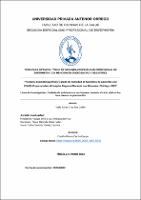Factores Sociodemográficos y grado de Ansiedad de familiares de pacientes con COVID-19 que acuden al Hospital Regional Docente Las Mercedes, Chiclayo, 2022
Resumen
El presente estudio tuvo como objetivo determinar la relación entre los factores sociodemográficos y el grado de ansiedad de familiares de pacientes con COVID-19 que acuden al Hospital Regional Docente Las Mercedes, Chiclayo 2022. La metodología, indica que es un estudio de enfoque cuantitativo, diseño no experimental, correlacional, la muestra fue: 140 familiares de pacientes con COVID19. Los resultados arrojaron que se halló más mujeres (64.3%) que hombres. Las edades fueron de 30 a 59 años. Predominó el estado civil de conviviente (40.7%). El nivel educativo superior fue 35.7%. La procedencia urbana fue 67.9% y la ocupación más frecuente fue la de empleado, con un 40%. El nivel de ansiedad que predominó fue el leve (47.1%). Siendo los síntomas somáticos generales y los temores obtuvieron la mayor severidad. Los síntomas leves observados en la entrevista fue 67.9% y el estado de ánimo deprimido (48.6%). Los síntomas moderados saltantes fueron el estado de ánimo ansioso y la tensión. Los síntomas graves frecuentes fueron los temores. Se concluyó: los factores sociodemográficos que se asociaron con el grado de ansiedad de familiares de pacientes con COVID-19 fueron el sexo, la edad, el estado civil, el nivel de instrucción y la ocupación The objective of this study was to determine the relationship between sociodemographic factors and the degree of anxiety of relatives of patients with COVID-19 who attend the Las Mercedes Regional Teaching Hospital, Chiclayo 2022. The methodology indicates that it is a study with a quantitative approach, a non-experimental, correlational design, the sample was: 140 relatives of patients with COVID19. The results showed that more women (64.3%) than men were found. The ages were from 30 to 59 years. The marital status of cohabiting prevailed (40.7%). The higher educational level was 35.7%. The urban origin was 67.9% and the most frequent occupation was that of employee, with 40%. The level of anxiety that predominated was mild (47.1%). Being the general somatic symptoms and the fears obtained the greatest severity. Mild symptoms observed in the interview was 67.9% and depressed mood (48.6%). Prominent moderate symptoms were anxious mood and tension. Frequent severe symptoms were fears. It was concluded: the sociodemographic factors that were associated with the degree of anxiety of relatives of patients with COVID-19 were sex, age, marital status, level of education, and occupation


